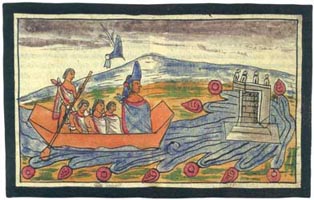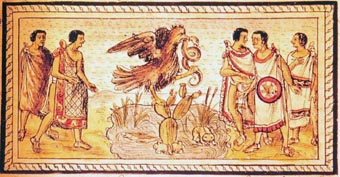Mexican History

By Frey Diego Duran in The History of the Indies of New Spain (circa 1581
The complete Indian history of Mexico has yet to be written. Even with the countless books, articles, and studies that abound today, the history of Mexico is still generally written from the viewpoint of the conquerors, or at least it reflects the attitudes of the more predominant sector of society. Much of the early history of the Aztecs was written by Spanish missionary-historians whose aim was to eliminate the native religion and convert the Indians to Catholicism. In view of the bias and hostility evident even in the most thorough and scholarly accounts, the question of historical reliability arises.
Religious Spanish-missionary historians wrote about Aztec beliefs and practices to provide other priests information useful in the conversion of the Indians. Therefore, even when they are describing Aztec history and religion, they are presenting an outsider’s view and interpretation. Consequently there is always the possibility of misrepresentation or misinterpretation of the native point of view.
To come closer to the native perspective, we must turn to the codices and painted picture books of Mexico. While most of these indigenous manuscripts were produced by native scribes and painters, there are some notable exceptions.
Diego Durán was born in Seville, Spain, in 1537 but came to Mexico as a boy. At first he lived in Texcoco but later moved to Mexico City. By then, the old Aztec world was in ruins but vestiges of the former Aztec empire remained. Durán was not only fluent in Nahuatl, the Aztec language, but he was acquainted with the Indians, some of whom had survived the Conquest.
He was therefore a first-hand witness of the conflict between the Spanish and Indian cultures. He became a Dominican priest in 1556 and, during the next 25 years of his life, he wrote three important books on the history, religion, and calendar of the pre-Hispanic Aztecs — The Book of the Gods and the Rites (1574-1576), The Ancient Calendar (circa 1579), and The History of the Indies of New Spain (circa 1581). Because of Durán’s first-hand experience in early post-Conquest Mexico, he is a primary source of information and his work is therefore referred to as the Durán Codex.
Durán’s History is based in part on pictorial manuscripts and oral tradition. Similarities in the accounts of Aztec history found in the works of Durán and two other early chroniclers, Juan de Tovar, and Jose de Acosta, have led scholars to postulate a common lost source known as “Cronica X,” although there were probably other pictorial manuscripts and oral traditions as well.
Another chronicle of this group is the Codex Ramírez, the first part of which is similar to Durán’s account of early Aztec history. Part of it however appears to be an original work based on earlier pictorial manuscripts. The Codex Ramírez comprises three sections — a history of the Aztecs, an account of the Gods and their festivals, and a short section on the calendar. The precise relationship between these early historical accounts and the presumed underlying pictorial manuscripts is a matter of scholarly debate.

Durán’s main historical work, the Historia de las Indias de Nueva España (History) comprises an extensive written text (in Spanish) and the so-called Atlas of Durán, a pictorial manuscript covering the whole of Aztec history from the migration of the Aztecs to the Spanish Conquest. The History itself deals with Mexica (Aztec) history from the Aztec migration from Aztlan to the destruction of Tenochtitlán.
The historical sequence of events can be reconstructed from the descriptions in the written text read in conjunction with the accompanying illustrated scenes in the Atlas of Durán. The parallel written account fills in the details so that the meaning of the corresponding pictorial record becomes quite clear. For example, both the History and the Atlas begin with the people setting out from seven symbolic caves and arriving at Coatepec (Serpent-Hill), Chapultepec (Grasshopper Hill) and other places. Eventually, they reach the lagoon of Mexico and found their capital of Mexico-Tenochtitlán.
The series of 78 paintings covers the entire history of the Aztecs, each plate illustrating an event recorded in the History. The written text was obviously based on pictorial manuscripts backed up by oral tradition, including interviews with Indian informants, and then expanded to describe in full the events and personages represented in the illustrations.
There is a close relationship between the History of Durán and the Codex Ramírez. At least part of the latter was probably copied from or based upon the former or perhaps they both had access to one common source (Cronica X) or other lost sources. The account and sequence of events is more or less the same in both the Durán Codex and the Codex Ramírez, although the treatment is somewhat different. It is likely, therefore, that the Codex Ramírez is not simply a slavish copy of Durán but is in part an original work as well.
To illustrate the relation between the Atlas of Durán and the written text of the History let us look at the illustration for Chapter 69 of the History. A ship is seen approaching the shore filled with Spaniards, who are easily identified by their garments. Closer to shore, a man in a small boat hauls in a fish. A man hiding in the upper branches of a tree overlooking the beach points toward the ship. The written text tells us that the man in the tree is an Aztec spy from the court of Moctezuma who has come to check out the rumor that the Spaniards have arrived. He sees the ship and watches as the small boat returns to the ship with fish for the crew. The spy then returns to Moctezuma to confirm reports of the Spanish arrival. By the time one has read the written text it is remarkably easy to go back to the corresponding illustration and reconstruct the entire scene or “chapter.” This is how Durán and other early chroniclers of Mexico made use of pre-existing pictorial manuscripts or native codices in their writing of early Aztec history. Historians of Mexico borrowed from one another without acknowledgment and also made extensive use of native oral traditions and pictographic codices. This combination helped to form the basis of many of these early histories of Aztec civilization prior to the Conquest.
The Durán Codex is a primary source of information on Aztec history, culture, and religion. However, Durán was still a Dominican friar and only secondarily a historian, and then only in the service of the Church. His intolerance and utter contempt for the ceremonies and religious beliefs he is recording are quite clearly revealed, especially in the Book of the Gods and Rites. He is horrified at the continuation of pre-Hispanic “pagan” beliefs and “idolatry” among supposedly recent converts to Christianity. Then, paradoxically, he laments the destruction of so many native codices or pictorial manuscripts by overly-zealous Spanish missionaries because the information thus lost could have been used by the priests to help in the conversion of the Indians. He denounces the Spanish clergy for allowing the Indians to backslide into their previous religious beliefs and practices, and blames them for not being fluent enough in Nahuatl to recognize the many ways in which the people still managed to practice their native religion in full view. Even in the course of describing a deity or a ceremony, Durán will interrupt the narrative to introduce an anecdote to prove his point or condemn the practice as the work of the Devil.
Durán demeans the Indians of “small intelligence” who therefore require priests who speak their language. He condemns the market place (tianguiz) because the Indians would rather go there than to the Heaven offered by the Church. Priests are advised to take care that Christian saints and Church rites are not replaced by pagan deities or used simply as an excuse to eat, drink, and get drunk, which, Durán says, is the ultimate aim of the ancient feasts. Among other things, Durán was horrified at the evil custom of men and women bathing together in the temascal (traditional sweat bath) — not simply because it was an old pagan custom that had to be eliminated but because of the evil that can come of men and women being mingled together in this way.
Durán contradicts himself. In the Book of Rites and Ceremonies he praises the Aztecs for their bravery but in the History he says that, among the evils that the Supreme Lord has visited upon the Indians is their cowardly heart, so fearful and timorous that thousands of them ran away from the 300 Spaniards who came ashore with Cortés. Durán concludes by saying that he wrote for the glory of God and the Blessed Virgin Mary, subject to correction by Mother Church. But at the same time he laments the fall of the grand and noble Aztec city of Tenochtitlán and acknowledges the misery and poverty that have befallen the people because of the Conquest.
